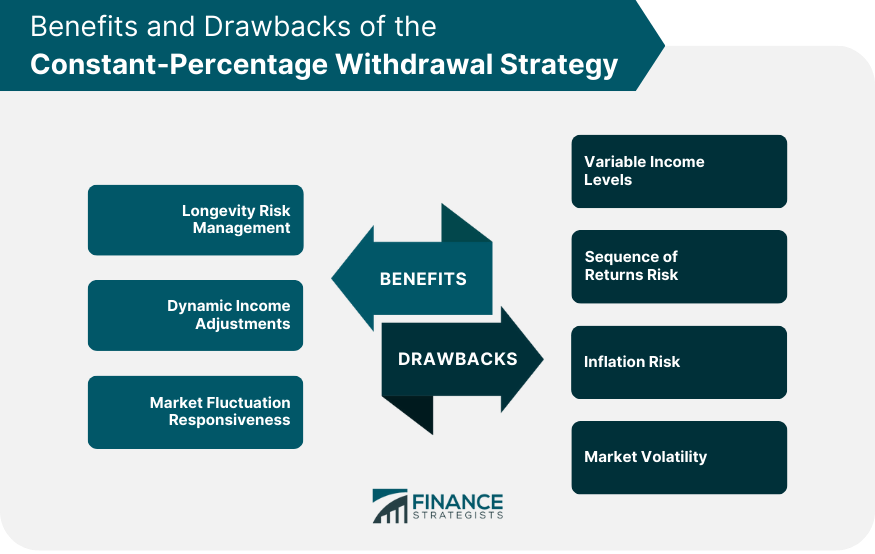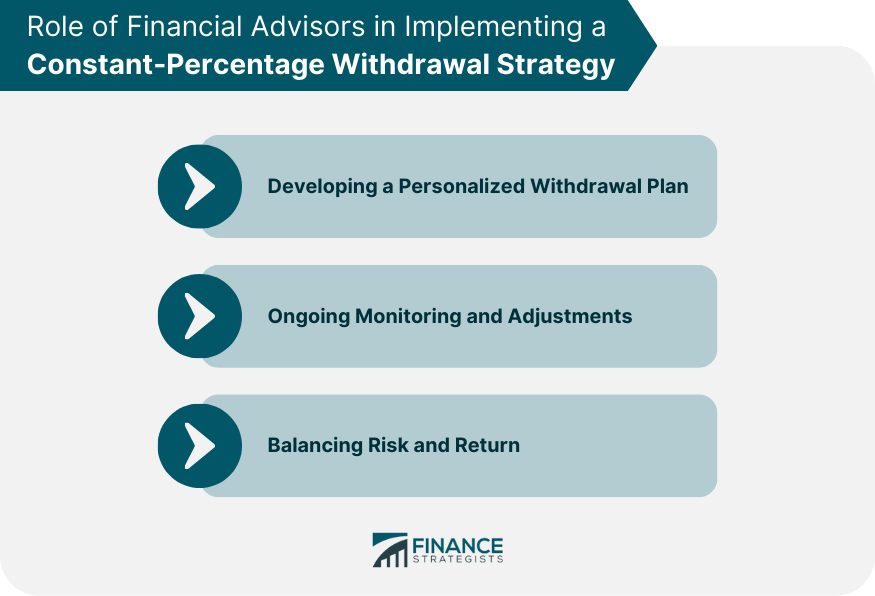The constant-percentage withdrawal strategy is a retirement income approach in which a retiree withdraws a fixed percentage of their investment portfolio's remaining value each year. This strategy aims to provide a sustainable income stream while adjusting to market fluctuations and minimizing the risk of outliving one's assets. The primary purpose of the constant-percentage withdrawal strategy is to generate a retirement income stream that adjusts to market conditions, ensuring a more stable and sustainable income throughout retirement. This approach helps retirees manage their spending while mitigating longevity risk and adapting to market fluctuations. The first step in implementing a constant-percentage withdrawal strategy is to determine a fixed withdrawal percentage. This percentage should be based on the retiree's anticipated spending needs, risk tolerance, and investment time horizon. A common starting point is to withdraw between 3% and 5% of the portfolio's remaining value each year. The constant-percentage withdrawal strategy involves calculating annual withdrawals based on the remaining portfolio value at the end of each year. By withdrawing a fixed percentage of the portfolio's value, the retiree's income will adjust to market conditions and fluctuate with the value of their investments. A constant-percentage withdrawal strategy requires careful management of the retiree's investment portfolio, with an appropriate mix of stocks, bonds, and other assets. The asset allocation should balance the need for growth to support withdrawals with the need to manage risk and preserve capital. Regular rebalancing of the investment portfolio is essential in a constant-percentage withdrawal strategy. Rebalancing ensures that the portfolio maintains its target asset allocation and reduces the risk of overexposure to any one asset class. This can help manage the impact of market volatility on the retiree's income and investment returns. When implementing a constant-percentage withdrawal strategy, it is essential to consider the retiree's personal risk tolerance. This will help determine the appropriate asset allocation and withdrawal percentage that balances the need for income and capital preservation. Understanding the retiree's retirement income needs is critical when implementing a constant-percentage withdrawal strategy. This information will inform the initial withdrawal percentage and help ensure that the plan is sustainable over the long term. The retiree's investment time horizon will also play a role in determining the appropriate withdrawal rate and asset allocation. A longer time horizon may allow for a higher withdrawal rate or a more aggressive asset allocation, while a shorter time horizon may require a more conservative approach. A well-diversified portfolio is essential when implementing a constant-percentage withdrawal strategy. Diversification can help manage risk and reduce the impact of market volatility on the retiree's income and investment returns. One of the primary benefits of the constant-percentage withdrawal strategy is its ability to manage longevity risk. By withdrawing a fixed percentage of the remaining portfolio value each year, the retiree is less likely to outlive their assets, as their income adjusts to the remaining portfolio balance. Another advantage of the constant-percentage withdrawal strategy is the dynamic income adjustments it offers. As the retiree's income is based on the remaining portfolio value, their income will increase during periods of strong investment performance and decrease during periods of poor performance, providing a natural hedge against market fluctuations. The constant-percentage withdrawal strategy is responsive to market fluctuations, as annual withdrawals are based on the remaining portfolio value. This allows retirees to benefit from market gains while also reducing the impact of market downturns on their income. One of the main risks associated with the constant-percentage withdrawal strategy is the potential for variable income levels. Since the annual withdrawal amount depends on the remaining portfolio value, the retiree's income may fluctuate significantly, making it difficult to plan and budget for expenses. The constant-percentage withdrawal strategy is also subject to sequence of returns risk, which refers to the potential negative impact of poor investment returns early in retirement. If the retiree experiences a significant market downturn shortly after beginning withdrawals, their portfolio value may be substantially reduced, leading to lower income levels throughout retirement. While the constant-percentage withdrawal strategy offers some protection against inflation through its dynamic income adjustments, it may not fully account for inflation's impact on purchasing power. If the withdrawal percentage is too low, the retiree may struggle to maintain their desired standard of living in the face of rising costs. Market volatility can pose a challenge for retirees using the constant-percentage withdrawal strategy. Significant market fluctuations can result in substantial changes in annual income, making it difficult for retirees to plan and budget for their expenses. The constant-dollar withdrawal strategy involves withdrawing a fixed dollar amount, adjusted for inflation, each year. This approach offers a more stable income stream but may not provide the same level of longevity risk protection as the constant-percentage withdrawal strategy. The percentage of portfolio withdrawal strategy involves withdrawing a fixed percentage of the portfolio's initial value each year, regardless of the remaining balance. This approach can provide more stable income levels but may not offer the same level of responsiveness to market fluctuations as the constant-percentage withdrawal strategy. The required minimum distribution (RMD) strategy involves withdrawing a minimum amount from retirement accounts each year, based on the retiree's age and account balance, as mandated by the IRS. This approach can help ensure that retirees do not outlive their savings but may not provide sufficient income or protection against inflation. Selecting the right withdrawal strategy depends on the retiree's individual financial circumstances, goals, and risk tolerance. It is essential to carefully consider the pros and cons of each approach and consult with a financial advisor to develop a personalized retirement income plan. Financial advisors can play a crucial role in developing a personalized constant-percentage withdrawal plan that aligns with the retiree's financial goals and circumstances. They can help determine the appropriate withdrawal rate, asset allocation, and rebalancing strategy, ensuring that the plan is sustainable and meets the retiree's needs. Financial advisors can also help monitor and adjust the constant-percentage withdrawal plan as needed to account for changes in personal circumstances, market conditions, or tax laws. This ongoing support can help ensure that the retiree's income remains stable and sufficient throughout their retirement. Working with a financial advisor can help retirees balance risk and return in their constant-percentage withdrawal strategy. Advisors can provide guidance on asset allocation, rebalancing, and risk management to help ensure that the retiree's income remains stable while minimizing the potential for significant losses in their investment portfolio. A well-planned withdrawal strategy is essential for retirees to ensure a stable, sustainable income stream that adapts to market conditions and preserves their wealth throughout retirement. The constant-percentage withdrawal strategy offers a dynamic approach to retirement income planning that can help manage longevity risk and respond to market fluctuations. It is crucial for retirees to carefully weigh the pros and cons of the constant-percentage withdrawal strategy and consider how well it aligns with their financial goals and personal circumstances. By working with a knowledgeable financial advisor and carefully considering the implications of this approach, retirees can develop a comprehensive retirement income plan that provides financial security and peace of mind throughout their golden years.What Is the Constant-Percentage Withdrawal Strategy?
How the Constant-Percentage Withdrawal Strategy Works
Determining the Withdrawal Percentage
Calculating Annual Withdrawals
Portfolio Asset Allocation
Rebalancing the Portfolio
Factors to Consider When Implementing a Constant-Percentage Withdrawal Strategy
Personal Risk Tolerance
Retirement Income Needs
Investment Time Horizon
Portfolio Diversification
Benefits of the Constant-Percentage Withdrawal Strategy
Longevity Risk Management
Dynamic Income Adjustments
Market Fluctuation Responsiveness
Potential Risks and Drawbacks
Variable Income Levels
Sequence of Returns Risk
Inflation Risk
Market Volatility

Comparison With Other Withdrawal Strategies
Constant-Dollar Withdrawal Strategy
Percentage of Portfolio Withdrawal Strategy
Required Minimum Distribution (RMD) Strategy
Choosing the Appropriate Withdrawal Strategy
Role of Financial Advisors in Implementing a Constant-Percentage Withdrawal Strategy
Developing a Personalized Withdrawal Plan
Ongoing Monitoring and Adjustments
Balancing Risk and Return

Conclusion
Constant-Percentage Withdrawal Strategy FAQs
A constant-percentage withdrawal strategy, also known as a systematic withdrawal plan, is a retirement income strategy where the retiree withdraws a fixed percentage of their investment portfolio every year. The percentage is based on the initial value of the portfolio, and it is adjusted each year to account for inflation.
Unlike a fixed-dollar withdrawal strategy, which can result in either too much or too little income depending on investment performance, a constant-percentage withdrawal strategy adjusts the amount of income based on portfolio value. This makes it a more flexible strategy that can better adapt to changing market conditions.
The safe withdrawal rate for a constant-percentage withdrawal strategy is typically considered to be 4% per year. This means that the retiree would withdraw 4% of their initial portfolio value in the first year of retirement and adjust the withdrawal amount each subsequent year for inflation.
One of the primary benefits of a constant-percentage withdrawal strategy is that it can help retirees maintain their purchasing power over time by adjusting the withdrawal amount for inflation. It can also help to reduce the risk of running out of money in retirement, as the withdrawal rate is adjusted each year based on portfolio value.
One potential drawback of a constant-percentage withdrawal strategy is that it may not be suitable for retirees who have a low tolerance for investment risk. If the investment portfolio experiences significant losses, the withdrawal amount may need to be reduced to avoid depleting the portfolio too quickly. Additionally, the strategy may not provide a guaranteed income stream, which can be a concern for some retirees who prefer more certainty in their retirement planning.
True Tamplin is a published author, public speaker, CEO of UpDigital, and founder of Finance Strategists.
True is a Certified Educator in Personal Finance (CEPF®), author of The Handy Financial Ratios Guide, a member of the Society for Advancing Business Editing and Writing, contributes to his financial education site, Finance Strategists, and has spoken to various financial communities such as the CFA Institute, as well as university students like his Alma mater, Biola University, where he received a bachelor of science in business and data analytics.
To learn more about True, visit his personal website or view his author profiles on Amazon, Nasdaq and Forbes.











